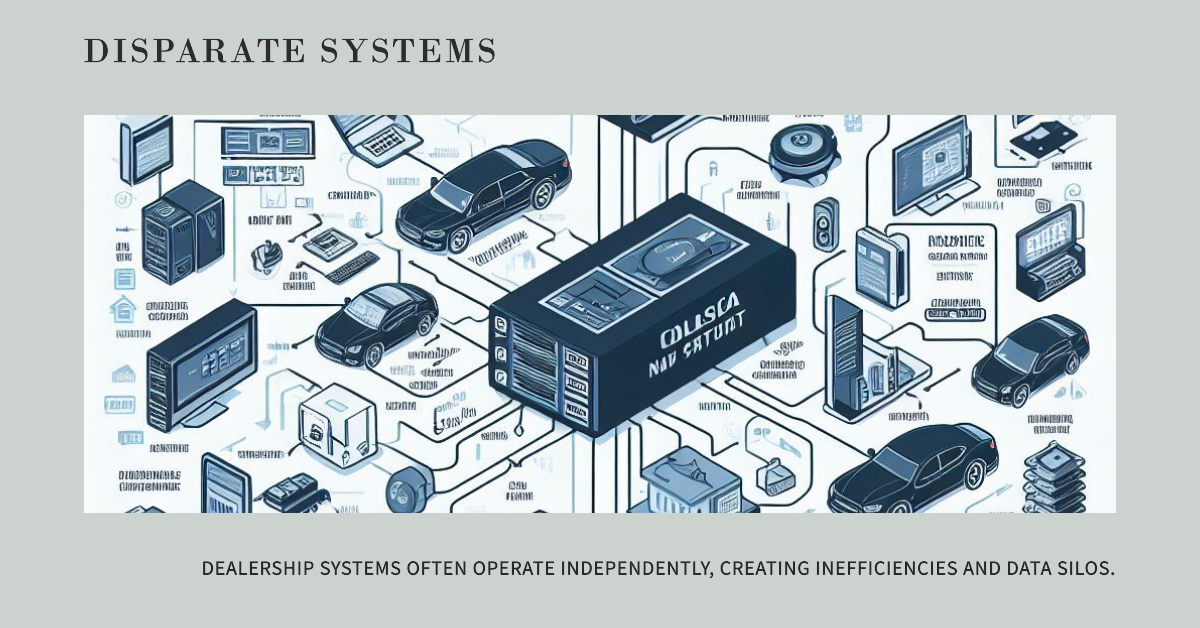
Disparate Systems
Disparate systems are autonomous data processing entities that lack connectivity and interaction with one another. Typical examples are legacy systems and heterogeneous database systems. In automotive retail, dealerships frequently grapple with such systems that manage sales, service, and inventory independently, usually originating from different vendors and lacking seamless integration.
Insight into Disparate Systems:

Legacy Systems: Outdated technologies or applications long in use, characterized by their non-communicative nature with newer systems.
Heterogeneous Database Systems: Databases that use varied management systems, run on different operating systems, or support diverse data models and APIs, resulting in isolated data pools.
Sector-Specific Systems: For instance, waste and recycling operations often involve multiple software, hardware, and technology systems that do not interact, such as separate billing and customer management systems.
Business Data Systems Variance: A business might manage customer information in a CRM like Salesforce, process eCommerce transactions via a platform like BigCommerce, and utilize an ERP system like Microsoft Dynamics for enterprise management, each operating in its own silo.
Dealership Challenges Stemming from Disparate Systems:
Inefficiency and Redundancy: Employees may enter the same data into different systems or constantly switch systems to complete processes, leading to lost time and potential errors.
Data Silos: The absence of data interchangeability hinders a unified operational view, obstructing strategic decision-making and improvement opportunities.
Subpar Customer Experience: Customers might have to repeat their information or may not view their complete account history, causing dissatisfaction.
Embracing Microservices Architecture:

Microservices architecture is the design and development of small, independent services that can be easily integrated and scaled, offering significant benefits to dealership operations.
Operational Streamlining: Microservices can automate processes across systems, cutting down on manual data entry and reducing error margins.
Customer Experience Enhancement: They enable more personalized interactions, such as monitoring vehicle repair status, scheduling services, and facilitating online transactions.
Agility and Innovation: Microservices allow for swift adjustments to market shifts and the introduction of new features without overhauling the entire system.
Cost Efficiency: They negate the necessity for complex, unwieldy monolithic systems, offering a more scalable and cost-effective alternative.
Roadmap for Implementing Microservices Architecture:
Technology Assessment: Pinpoint areas where microservices can deliver the most impact.
Strategic Transition Planning: Create a phased approach for integrating new microservices while phasing out obsolete systems.
Tool and Technology Selection: Identify the optimal tools and technologies for microservices development and deployment.
Staff Training: Equip the team with knowledge about the new architecture and best practices in development.
Phased Rollout: Introduce microservices gradually, carefully monitoring their performance.
Microservices architecture is poised to be the linchpin of future-proof dealership technology.

The illustrative contrast in the image sheds light on the dichotomy between Disparate Systems and Microservices Architecture. The left side’s segmented layout represents isolated systems managing various dealership functions independently. In stark contrast, the right side shows a network of interconnected services, symbolizing the collaborative and scalable nature of microservices architecture. This visual metaphor captures the evolution from an isolated to an integrated system, advocating for microservices as a strategic solution to the inefficiencies caused by disparate systems. It highlights the role of strategic planning and collaboration for dealerships on the cusp of this transformative journey.
Picture your dealership’s technology as dynamic and forward-thinking as your business model—a platform customizable, scalable, and integratable with ease. Microservices architecture is the key to turning this concept into reality.
To advance your dealership’s technology infrastructure, keep an eye on my forthcoming articles. They will explore the nuances of microservices architecture and offer guidance on initiating its real-world development.